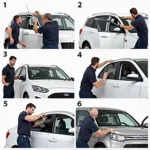A comfortable car seat is essential for enjoyable driving, but over time, wear and tear can take a toll on your seat cushions. Fortunately, you don’t always need a mechanic to fix a sagging or uncomfortable car seat. This guide will teach you how to repair a car seat cushion and restore its comfort and support.
Assessing the Damage
Before you start gathering tools and materials, it’s crucial to identify the root of the problem. Car seat cushions can lose their comfort and support due to various reasons, and each issue requires a slightly different approach.
- Worn-out Padding: The most common culprit is compressed or deteriorated foam padding. Over time, the foam loses its resilience and ability to spring back to its original shape, resulting in a flat and uncomfortable seat.
- Broken Springs: If you feel a noticeable dip or hear squeaking noises when you sit, you might have a broken spring in the seat frame.
- Torn Upholstery: While not directly affecting the cushion itself, torn upholstery can expose the padding to further damage and create an unsightly appearance.
Gathering Your Tools and Materials
Once you’ve pinpointed the problem, gather the necessary tools and materials for the repair:
- Replacement Foam: Choose high-density foam that matches the thickness and firmness of your original padding.
- Upholstery Fabric (if needed): Select durable fabric that matches or complements your car’s interior.
- Hog Ring Pliers: These specialized pliers are essential for securing upholstery fabric to the seat frame.
- Scissors: Sharp fabric scissors for cutting foam and upholstery.
- Utility Knife: Useful for trimming foam to the desired shape.
- Screwdrivers: To remove the car seat from the vehicle and access the cushion.
- Marker or Pen: For marking cutting lines on the foam.
- Spray Adhesive (optional): Helps secure the new foam to the seat frame.
Repairing a Worn Car Seat Cushion
If you’ve determined that your car seat cushion simply needs new padding, follow these steps:
-
Remove the Car Seat: Consult your car’s owner’s manual for instructions on removing your specific seat. Typically, you’ll need to unbolt the seat from the vehicle floor.
-
Access the Cushion: Depending on your car model, you might need to remove additional covers or trim pieces to reach the seat cushion.
-
Remove Old Padding: Carefully detach the old foam padding from the seat frame. Take note of how it was attached, as you’ll need to replicate this when installing the new padding.
-
Cut New Foam: Use the old padding as a template and trace its outline onto the new foam using a marker. Cut the new foam slightly larger than the tracing to ensure a snug fit.
 Replacing Car Seat Padding
Replacing Car Seat Padding
-
Attach New Padding: Apply spray adhesive to the seat frame and carefully position the new foam padding. Press firmly to ensure a secure bond.
-
Reassemble the Seat: Follow the disassembly steps in reverse order to put your car seat back together.
Dealing with Broken Springs
If your car seat cushion suffers from broken springs, it’s best to consult a professional upholsterer or mechanic. Repairing broken springs requires specific knowledge and tools, and attempting to fix them yourself could lead to further damage.
However, you can learn more about how to repair car seat springs in our comprehensive guide: how to repair car seat springs.
Repairing Worn Car Seat Padding and Upholstery
Worn-out car seat padding and torn upholstery not only affect your comfort but also the aesthetics of your car’s interior. While replacing the entire seat cushion might seem like the easiest solution, repairing the existing one can be a cost-effective alternative.
For a detailed guide on how to repair worn car seat padding and tackle upholstery issues, check out our dedicated articles:
Addressing Other Common Car Seat Issues
While this guide focuses on repairing car seat cushions, there are other common car seat issues you might encounter. Let’s explore a couple of them:
Cigarette Burns
Small cigarette burns are an unfortunate reality for some car owners. These unsightly blemishes can be surprisingly difficult to completely remove, but there are ways to minimize their appearance.
Learn how to tackle those pesky cigarette burns in our detailed guide: how to repair small cigarette burn in car seat.
Deployed Airbags
Airbag deployment is a crucial safety feature in case of accidents, but it can leave your car seats in need of repair. If your car seat airbags have deployed, it’s vital to address the issue properly to ensure your safety and the functionality of the airbags in the future.
Find out more about car seat airbag repair in our informative article: is car seat airbags deploy can repair.
Conclusion
Repairing a car seat cushion is a manageable DIY project that can save you money and restore the comfort of your drive. By identifying the source of the problem and following the appropriate steps, you can revitalize your car seats and enjoy a more pleasant driving experience. Remember, if you encounter more complex issues like broken springs, it’s best to seek professional assistance.

